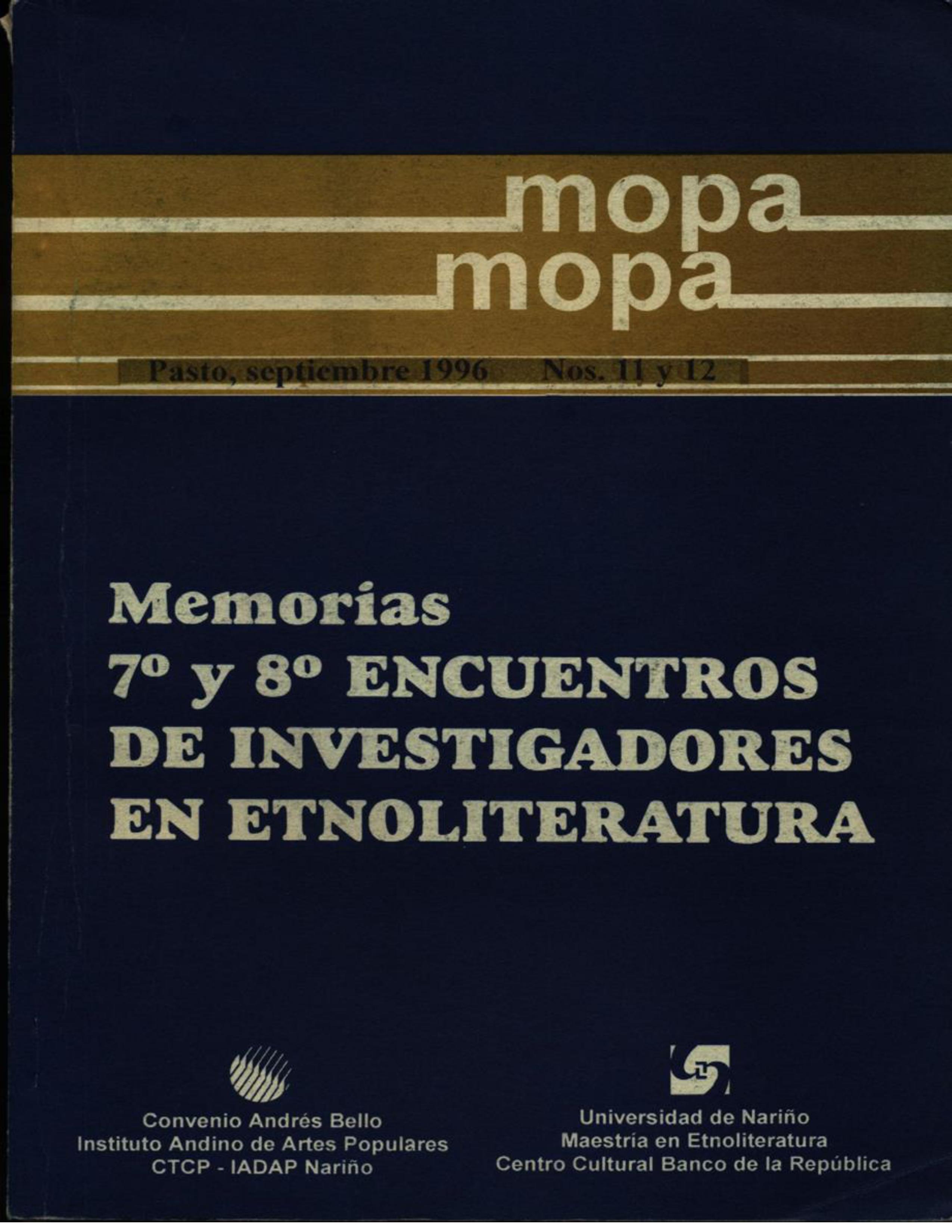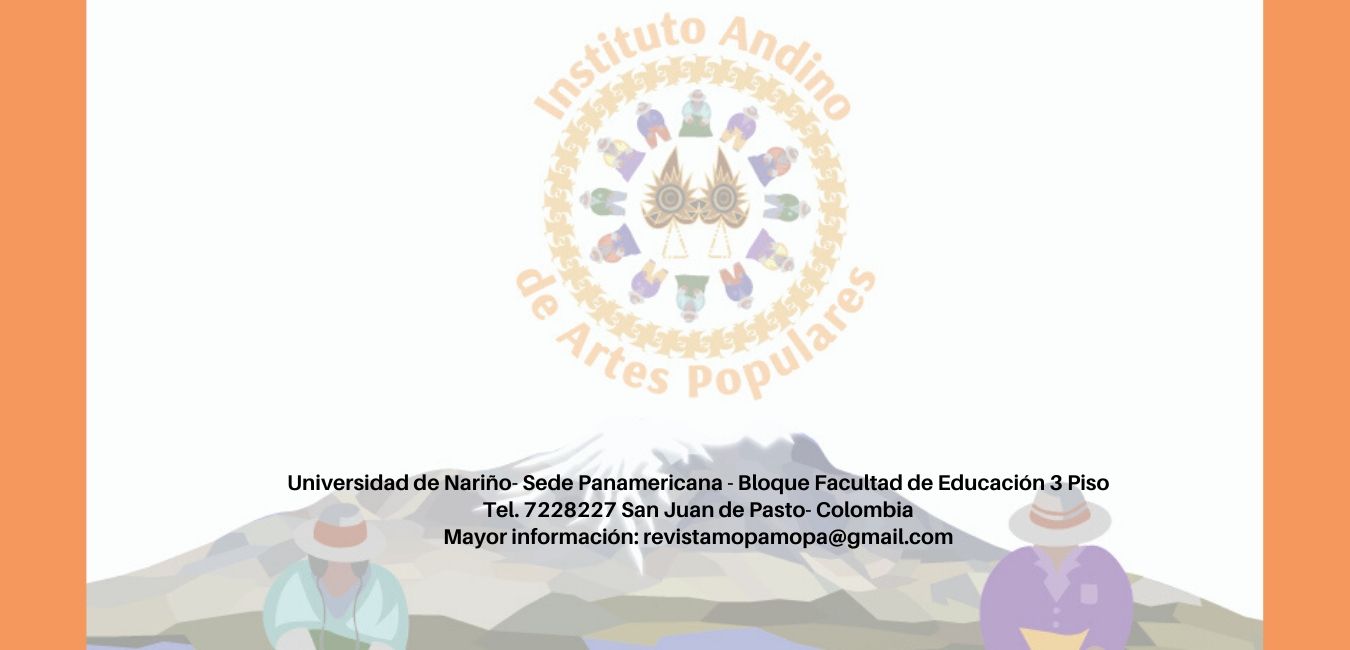Diablo, metáforas y cambio social
Palabras clave:
Imagenes catolicas, Costa Norte de Ecuador, SentimientosResumen
En la presente exposicion explorare la manera en la cual las imagenes catolicas son reapropiadas por los habitantes de la Costa Norte de Ecuador para expresar sus frustraciones, deseos y esperanzas. Enfatizare la utilizacion creativa de las figuras religiosas como comentario sobre tensiones sociales y las transformaciones socio-economicas.
Descargas
Los datos de descargas todavía no están disponibles.
Citas
ALLEN, Catherine. The hold life has: Coca and Cultural Identity in an Andean Community. Washington: Smithsonian Institute Press, 1988.
BASTIEN, Joseph W. Qollahauya- Andean Body Concepts: A Topographical Hydraulic Model of Physiology. American Anthropologist 87 (3): 595-611. 1985.
CRAIN, Mary. Poetics in the Ecuadorian Andes: Women`'s Narratives of Death and Devil Possession. American Anthropologist 18: 67-89, 1991.
ESCOBAR, Martha. La frontera imprecisa: lo natural y lo sagrado en el norte de Esmeraldas. Quito: Centro Cultural Afro- Americano, 1990.
GUSS, David. The Selling of San Juan: The performance of History in an Afro-Venezuelan Community. American Etnologist 20 (3): 451-473. 1993.
GUDERMAN, Stephen y Alberto RIVERA. Conversations in Colombia: The domestic economy in life and text. Cambridge: Cambridge University Press, 1990.
HOWARD- MALVERDE, Rosaleen. Significados del "Dyablu" en el Relato Quichua del Cañar. En: Antropologia del Ecuador: Memorias del Primer Simposio Europeo de Antropologia del Ecuador. Segundo E. Moreno Yanez, ed. 1989. Coleccion 500 años #8
NASH, June. The Devil in Bolivia's Nationalized tin mines. Science and society 36, N. 2:69-82. 1972.
NUÑEZ DEL PRADO, Oscar. El mundo sobrenatural Quechua del Sur del Peru, a traves de la Comunidad de Qotobamba. Allpanchis (Cuzco) 2: 135-56. 1970.
SIVERBLATT, Irene. Moon, Sun and Witches: Gender Ideologies and Class in Inca and Colonial Peru. Princeton University Press, 1987.
TAUSSIG, Michael. The devil and Commodity Fetishism in South America- Chapel Hill: University of Northern Carolina Press, 1980.
______________________ Shamanism, Colonialism and the Wild Man: A study in terror and healing. Chicago: University of Chicago Press, 1987.
TURNER, Victor. Dramas, Fields and Metaphors: Symbolic Antion to Human Society. Ithaca: Cornell University, 1974-
TURNER, Terence. Production, Eploitation and Social Consciousness in the "Peripheral Situation". Social Anlysis N. 19, August 1986.
WEISMANTEL, Mary. Food, Gender and Poverty in the Ecuadorian Andes. Philadelphia: University of Pennsylvania Press, 1988.
WHITTEN, Jr. Norman E. Sicuanga Runa Urbana: The other side of development in Amazonian Ecuador. University of Illinois Press, 1986.
__________________ Pioneros Negros: La cultura Latinoamericana del Ecuador y de Colombia. Quito: Centro Cultural Afro-Ecuatoriano, 1992.
BASTIEN, Joseph W. Qollahauya- Andean Body Concepts: A Topographical Hydraulic Model of Physiology. American Anthropologist 87 (3): 595-611. 1985.
CRAIN, Mary. Poetics in the Ecuadorian Andes: Women`'s Narratives of Death and Devil Possession. American Anthropologist 18: 67-89, 1991.
ESCOBAR, Martha. La frontera imprecisa: lo natural y lo sagrado en el norte de Esmeraldas. Quito: Centro Cultural Afro- Americano, 1990.
GUSS, David. The Selling of San Juan: The performance of History in an Afro-Venezuelan Community. American Etnologist 20 (3): 451-473. 1993.
GUDERMAN, Stephen y Alberto RIVERA. Conversations in Colombia: The domestic economy in life and text. Cambridge: Cambridge University Press, 1990.
HOWARD- MALVERDE, Rosaleen. Significados del "Dyablu" en el Relato Quichua del Cañar. En: Antropologia del Ecuador: Memorias del Primer Simposio Europeo de Antropologia del Ecuador. Segundo E. Moreno Yanez, ed. 1989. Coleccion 500 años #8
NASH, June. The Devil in Bolivia's Nationalized tin mines. Science and society 36, N. 2:69-82. 1972.
NUÑEZ DEL PRADO, Oscar. El mundo sobrenatural Quechua del Sur del Peru, a traves de la Comunidad de Qotobamba. Allpanchis (Cuzco) 2: 135-56. 1970.
SIVERBLATT, Irene. Moon, Sun and Witches: Gender Ideologies and Class in Inca and Colonial Peru. Princeton University Press, 1987.
TAUSSIG, Michael. The devil and Commodity Fetishism in South America- Chapel Hill: University of Northern Carolina Press, 1980.
______________________ Shamanism, Colonialism and the Wild Man: A study in terror and healing. Chicago: University of Chicago Press, 1987.
TURNER, Victor. Dramas, Fields and Metaphors: Symbolic Antion to Human Society. Ithaca: Cornell University, 1974-
TURNER, Terence. Production, Eploitation and Social Consciousness in the "Peripheral Situation". Social Anlysis N. 19, August 1986.
WEISMANTEL, Mary. Food, Gender and Poverty in the Ecuadorian Andes. Philadelphia: University of Pennsylvania Press, 1988.
WHITTEN, Jr. Norman E. Sicuanga Runa Urbana: The other side of development in Amazonian Ecuador. University of Illinois Press, 1986.
__________________ Pioneros Negros: La cultura Latinoamericana del Ecuador y de Colombia. Quito: Centro Cultural Afro-Ecuatoriano, 1992.
Descargas
Publicado
1998-10-05
Cómo citar
Quiroga, D. (1998). Diablo, metáforas y cambio social. Mopa Mopa, 2(11Y12), 181–194. Recuperado a partir de https://revistas.udenar.edu.co/index.php/rmopa/article/view/5249
Número
Sección
Artículos
Licencia
Al presentar un artículo a la revista Mopa Mopa, el autor declara que es titular de su autoría y derecho de publicación; derecho que lo comparte con el Instituto Andino de Artes Populares de la Universidad de Nariño, manteniendo, desde luego, su derecho de autoría. Si el autor ha presentado el mismo artículo a otra publicación, debe notificarlo al editor de la revista.



